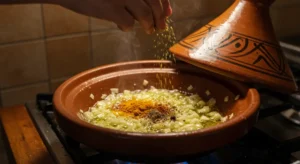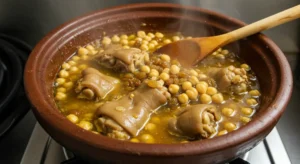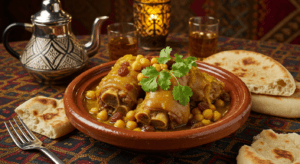Table of Contents
What is Hargma? A Traditional Moroccan Tagine Food
Origins of Hargma in Moroccan Tagine Food
Hargma is a traditional Moroccan Tagine food that has been part of the country’s culinary heritage for centuries. This slow-cooked delicacy is deeply rooted in Berber and Andalusian influences, making it a staple in many Moroccan households, especially in cities like Marrakech and Fès, known for their rich food culture.
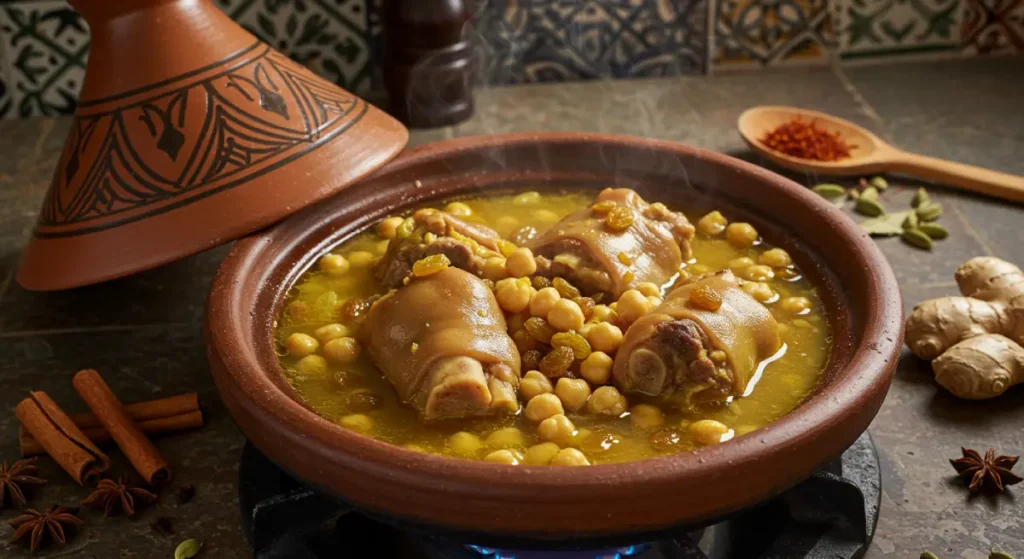
More than just a dish, Hargma symbolizes nourishment and togetherness. It is often prepared during religious holidays, family gatherings, and cold seasons due to its hearty and warming nature. In Marrakech, locals bring their ingredients to communal ovens, allowing the dish to simmer for hours, intensifying the flavors. Meanwhile, the Fassi version is enhanced with saffron and floral notes of orange blossom water, adding a refined t…
Beyond its regional variations, Hargma carries a deep cultural significance. The slow cooking method, the use of rich spices, and the communal aspect of preparing and sharing the meal make it an essential part of Moroccan tagine food traditions.
What Makes Hargma an Unique Tagine Food?
Hargma stands out from other Moroccan Tagine food due to its distinctive preparation and flavor profile. Unlike standard lamb or chicken Tagines, Hargma is made using lamb or beef trotters, which contribute to the dish’s gelatinous, collagen-rich broth. This gives it a luxurious texture that is both hearty and nutritious.
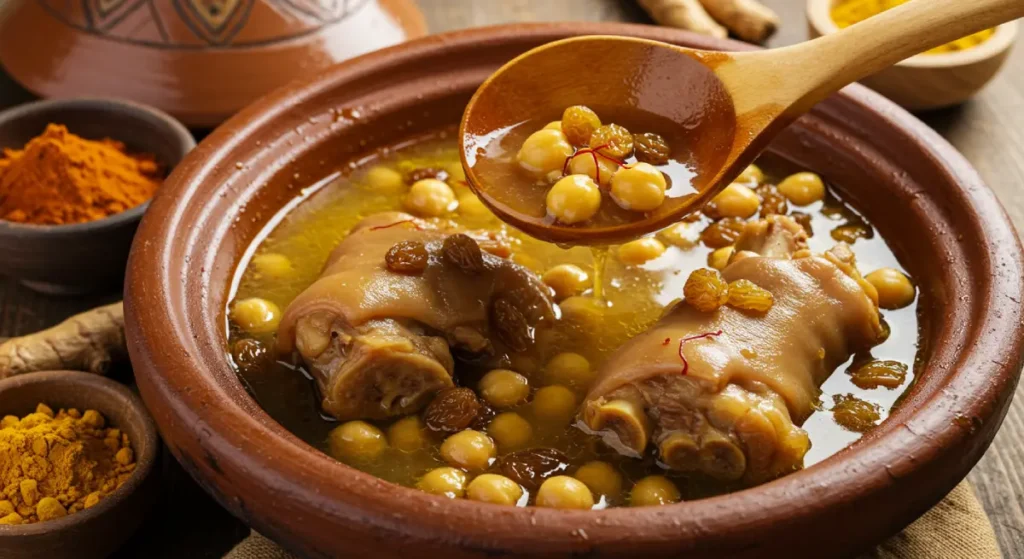
The Signature Ingredients
The magic of this Tagine food lies in its unique blend of ingredients. A careful balance of cinnamon, ginger, turmeric, black pepper, and Ras el Hanout creates an aromatic and deeply flavorful broth. Some variations include fermented butter (smen) for an aged, complex taste that lingers on the palate.
The Sweet & Savory Balance
What truly sets Hargma apart as a Tagine food is its balance between sweet and savory elements. The addition of golden raisins and slow-cooked chickpeas contrasts textures and flavors, with the dried fruit’s natural sweetness complementing the broth’s rich umami notes. This interplay of flavors is a defining characteristic of Moroccan cuisine, where subtle layers of taste unfold with every bite.
Another hallmark of this tagine food (Hargma) is its slow-cooking method. The key is low heat and patience, whether prepared in a traditional clay tagine, a heavy-bottomed pot, or a modern pressure cooker. This prolonged cooking time allows the meat’s connective tissues to break down, creating a dish that is as nourishing and flavorful.
Hargma vs. Other Moroccan Tagine food
While Hargma shares the essence of slow-cooked Moroccan stews, it is distinct from other tagine dishes in terms of ingredients and preparation.
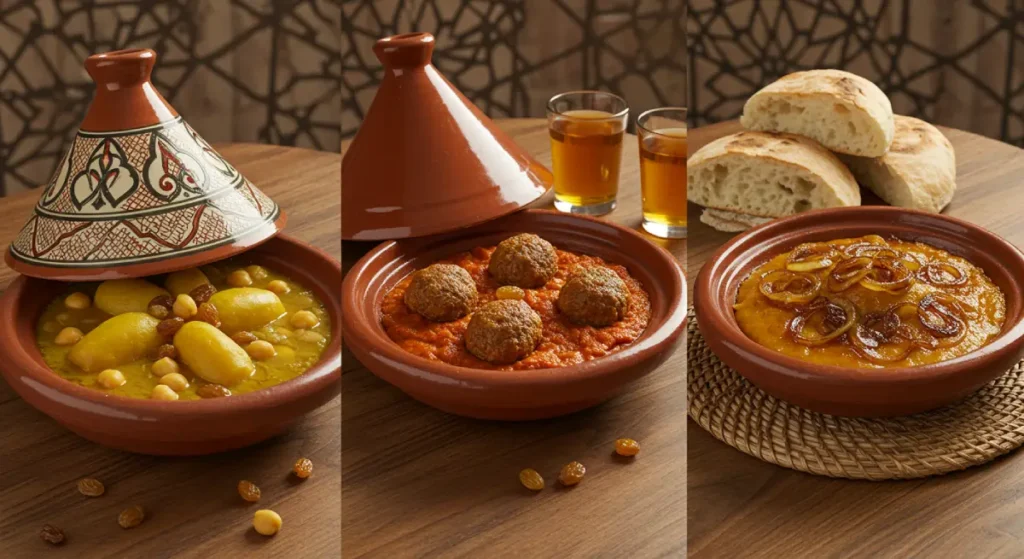
- Hargma vs. Tajine Kefta
Tajine Kefta, a beloved Moroccan dish featuring spiced ground meatballs simmered in a rich tomato sauce, is vastly different from Hargma. While Kefta is known for its vibrant, tangy, and slightly spicy profile, Hargma boasts a deep, gelatinous broth with a delicate interplay of warm spices and sweetness. The texture is another stark contrast—Kefta has a more uniform, tender bite, whereas Hargma is characterized by succulent, fall-apart meat on the bone. - Hargma vs. Tajine Makfoul
Tajine Makfoul, a dish often prepared with braised lamb or beef and caramelized onions, emphasizes earthy and sweet flavors. Honey and cinnamon enhance the natural sugars in the onions. While Makfoul shares the concept of balancing sweet and savory flavors with Hargma, it lacks the viscous, collagen-rich texture that defines Hargma’s broth.
Another fundamental distinction is the cooking duration and broth consistency. Tajine Makfoul is cooked relatively shorter, making the meat tender yet structured. Hargma requires prolonged simmering, resulting in an unctuous, silky, and deeply infused with bone marrow goodness.
Ultimately, Hargma occupies a special place in Moroccan Tagine food. It offers a uniquely nutritious, aromatic, and indulgent experience that few other dishes can replicate.
If you enjoy discovering rich Moroccan flavors, you might also like trying the Moroccan Chicken Tagine with Preserved Lemons and Olives, another classic and flavorful tagine from Moroccan cuisine.
Ingredients Needed for Moroccan Hargma Tagine Food
The essence of this Moroccan tagine food (Hargma) lies in its rich, slow-simmered broth, which makes it a perfect Tagine food. Each component contributes to the dish’s silky texture, aromatic depth, and nourishing qualities.
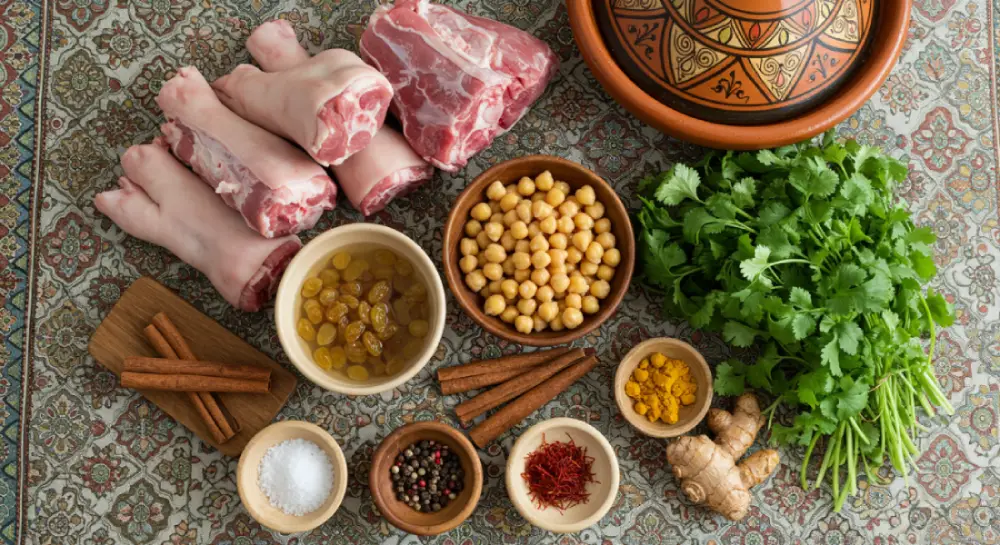
Main Ingredients 🥩
- Lamb or Beef Feet (Hargma) 🦴
The star of this dish, lamb or beef trotters, is the key to Hargma’s signature gelatinous and velvety texture. Their connective tissues and marrow break down as they cook, enriching the broth with collagen and giving it a deep, umami-packed essence. The result? A broth that is both healing and luxurious—a perfect antidote to chilly evenings or post-fasting recovery. - Chickpeas (Pois Chiches)
Tender, nutty, and subtly creamy chickpeas bring body and balance to the dish. They absorb the fragrant broth, making each bite an explosion of spiced goodness. Soaking them overnight ensures they cook evenly and retain their shape, providing the perfect contrast to the melt-in-your-mouth meat. - Golden Raisins (Raisins Secs Dorés)
Golden raisins are a classic ingredient in Moroccan cuisine. They lend a hint of natural sweetness that complements the dish’s savory backbone. As they simmer, they plump up, releasing honeyed undertones that meld beautifully with the deep spices. - Saffron (Safran)
Often called “red gold,” saffron elevates Hargma with its delicate floral aroma and vibrant golden hue. Just a few strands bloom in the hot broth, adding an ethereal richness that makes the dish unmistakably Moroccan. - Cinnamon (Cannelle)
Cinnamon is a warm, woody spice that imparts an aromatic sweetness. It is the bridge between the dish’s savory and subtly caramelized elements. Unlike in Western cuisine, where cinnamon is often reserved for desserts, Moroccan cooking is a cornerstone of stews and tagines, enhancing depth without overpowering.
👉 “Saffron’s unique properties and culinary uses have even been studied for their health benefits (source – Cleveland Clinic).”
Essential Moroccan Spices for Flavor
The heart of any Moroccan tagine food is its meticulously curated blend of spices, carefully measured to create harmony. Hargma is no exception.
- Ras el Hanout
Meaning “head of the shop,” this iconic spice blend is a complex medley of a merchant’s finest spices. It typically includes cardamom, nutmeg, cloves, paprika, cumin, and dried rose petals, adding layers of warmth, smokiness, and floral elegance to the broth. - Ginger (Gingembre)
Fresh and peppery, ginger provides a subtle heat that lingers on the tongue. It also aids digestion, making it a perfect companion to Hargma’s rich, collagen-infused broth. - Turmeric (Curcuma)
Turmeric, revered for its golden color and mild bitterness, is essential in Moroccan stews. It imparts an earthy depth and, when combined with saffron, creates a luminous, golden-hued broth that is visually appealing and packed with antioxidants. - Black Pepper (Poivre Noir)
More than just a finishing touch, black pepper enhances the potency of the other spices, amplifying the warmth of cinnamon and ginger. Its slight pungency cuts through the richness of the broth, ensuring that the dish remains balanced and layered in taste.
👉 “If you love rich Moroccan spice blends, you’ll also enjoy our Epic Tangia, a slow-cooked dish infused with saffron, cumin, and preserved lemon — a true explosion of traditional flavors.”
Key Cooking Utensils for a Perfect Tagine Food
The right cooking vessel can elevate Hargma from delicious to unforgettable. Traditional Moroccan kitchens rely on cookware that coaxes out flavors through slow, even heat distribution.
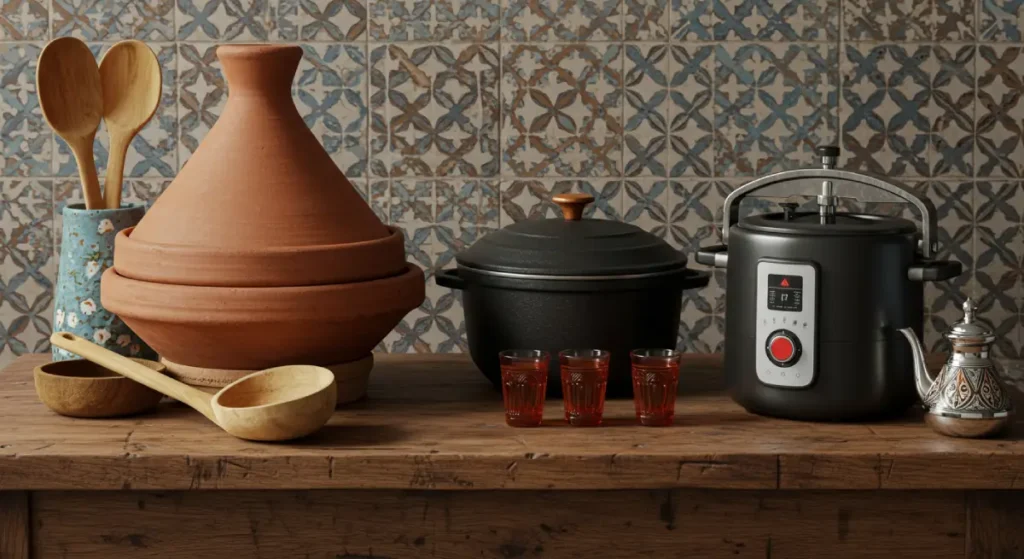
- Traditional Tagine Pot (Le Tagine en Terre Cuite)
Crafted from unglazed clay, a tagine pot traps steam, allowing flavors to concentrate and deepen as the dish cooks slowly over low heat. The conical lid circulates moisture, keeping the broth silky and rich while ensuring the meat tenderizes perfectly. This method results in a dish steeped in authenticity, with every bite infused with layers of Moroccan heritage. - Heavy-Bottomed Dutch Oven
A cast-iron Dutch oven is the next best option if a traditional tagine pot is unavailable. Its ability to retain and distribute heat evenly mimics the slow-cooking process of a tagine, producing a similarly succulent and aromatic dish. - Pressure Cooker (Autocuiseur)
Modern kitchens often use pressure cookers, dramatically reducing cooking time pressure cookers reduce for convenience. While they lack the romance of slow cooking, they dramatically reduce cooking time, allowing the broth to develop a deep, complex flavor. This is a practical alternative for those short on time but unwilling to compromise on taste. - Wooden Spoon & Ladle
Stirring Hargma with a wooden spoon prevents the delicate ingredients from breaking apart. A deep ladle is also essential for serving, ensuring each portion perfectly balances broth, meat, chickpeas, and raisins.
Every ingredient and utensil contributes to Hargma’s authenticity and depth. Whether using a traditional clay tagine or a modern pressure cooker, the goal remains: creating a dish that celebrates Moroccan culinary artistry, packed with soul-warming flavors and nourishing richness.
Step-by-Step Guide to Cooking Hargma Tagine Food
.This dish is not merely cooked—it is nurtured into existence; crafting an authentic Hargma Tagine food requires patience, precision, and an appreciation for slow-simmered, allowing each ingredient to unveil its essence in the broth. Every step plays a vital role in achieving the perfect balance of savory depth, subtle sweetness, and aromatic warmth.
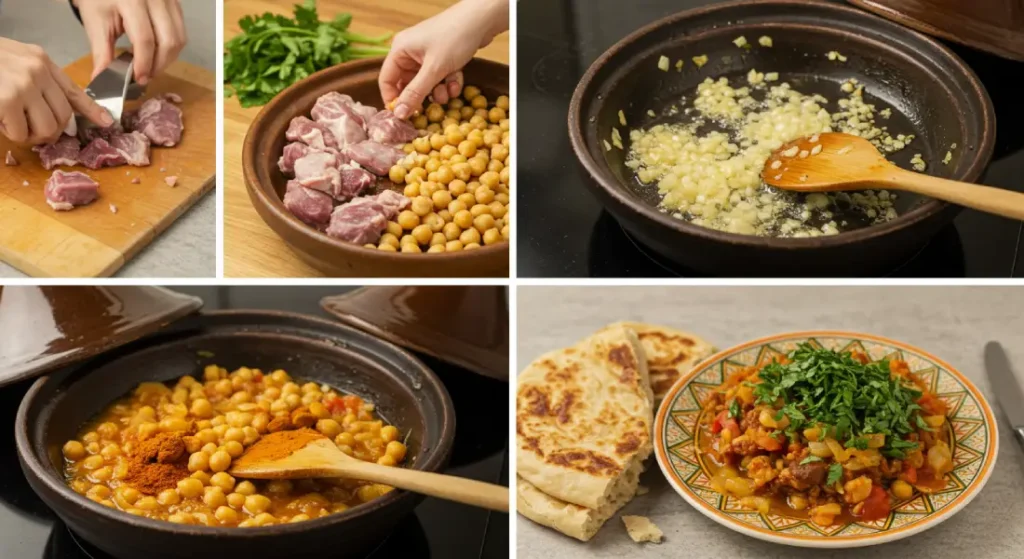
Step 1: Preparing the Meat & Ingredients
The foundation of Hargma lies in its meticulous preparation. Since lamb or beef feet contain gelatinous connective tissue, proper cleaning is crucial to ensure a pure, refined broth.
- Cleaning the Meat:
Begin by scorching the trotters over an open flame to remove residual hair, commonly used in traditional Moroccan kitchens. Rinse thoroughly under cold running water, scrubbing away any impurities. Some prefer to soak them in water and vinegar for an hour, which helps neutralize any gamey undertones. - Soaking the Chickpeas:
Dried chickpeas require overnight soaking to achieve a tender, buttery texture. A pinch of baking soda in the water expedites softening, ensuring they cook evenly and absorb the deeply spiced broth. - Prepping the Spice Blend:
In a small bowl, mix the essential spices—Ras el Hanout, turmeric, cinnamon, black pepper, and ginger. Lightly toasting the spices in a dry pan for a few seconds unlocks their volatile oils, intensifying their fragrance and flavor profile.
“Soaking the meat in vinegar water is a well-known technique used to neutralize strong odors and soften tissues (source – USDA Food Safety Education)”
Step 2: Slow-Cooking the Hargma
Time and low heat are the guardians of Hargma’s soul. Whether using a traditional clay tagine, a Dutch oven, or a pressure cooker, the goal remains the same: a deeply infused broth with fall-apart tender meat.
- Choosing the Cooking Vessel:
A clay tagine is ideal for an authentic, slow-extracted flavor, but a Dutch oven or pressure cooker can be used for convenience. A tagine takes several hours to cook, while a pressure cooker can achieve similar results in under two hours. - Browning the Trotters:
Heat a generous drizzle of olive oil over medium heat in a heavy-bottomed pot. Add the trotters and sear them until lightly browned, allowing the surface to develop a subtle caramelization that enriches the broth. - Building the Base Flavor:
Toss in sliced onions, garlic, fresh cilantro and parsley. Sprinkle in the spice blend, letting it coat the ingredients in a golden hue. Stir gently to ensure even distribution of the aromatics. - Simmering to Perfection:
Pour enough water to submerge the meat entirely, then bring it to a gentle simmer. Cover with a lid, and let the magic unfold—low, slow heat will coax out the marrow, gelatin, and richness from the trotters, transforming the broth into a luxurious, velvety elixir.
Step 3: Adding Chickpeas & Raisins for the Final Touch
As the broth thickens and the meat reaches its melt-in-the-mouth tenderness, it’s time to introduce texture and contrast.
- Adding the Chickpeas:
Drain the chickpeas that have been soaking and toss them into the pot. - They will absorb the complex layers of spices, lending the dish a hearty, nutty depth.
- Incorporating the Raisins:
Golden raisins go in last. Their natural sugars meld seamlessly into the broth, enhancing the savory-sweet interplay characteristic of Moroccan cuisine. A handful of toasted almonds can be added for a slight crunch, elevating the texture further. - Adjusting Seasoning & Consistency:
Taste the broth—does it need a pinch of black pepper for warmth, cinnamon for roundness, or saffron for brightness? Adjust accordingly. If the liquid has reduced too much, a splash of hot water or homemade bone broth can restore the desired consistency.
Step 4: Serving Suggestions for an Authentic Experience
Hargma is not merely served; it is reverently presented, accompanied by classic Moroccan side Tagine food highlighting its robust character.
- Bread Pairing:
Serve with freshly baked Khobz (Moroccan semolina bread) or Msemen (flaky Moroccan flatbread), which is ideal for soaking up the luscious broth. - Garnishing for Elegance:
A sprinkle of toasted sesame seeds, a few sprigs of fresh cilantro, or a drizzle of Argan oil adds a final layer of finesse. - Complementary Sides:
Pair Hargma with a light Harira soup or a simple Moroccan salad of tomatoes, cucumbers, and preserved lemons. These dishes offer a refreshing counterbalance to the stew’s richness. - Drinks to Enhance the Meal:
A glass of freshly brewed Moroccan mint tea or a slightly tart pomegranate juice beautifully rounds out the meal, providing a crisp, palate-cleansing finish.
Hargma is more than just food—an ode to Moroccan culinary heritage. ThisTagine Food embodies time-honored traditions, familial warmth, and the art of slow cooking. It becomes a soul-nourishing experience steeped in flavor and history when prepared with patience and care.
Health Benefits of Hargma – More Than Just a Comfort Food
Hargma is more than a dish; it is a nourishing elixir deeply rooted in Moroccan tagine food tradition. Beyond its soul-warming flavors, it boasts an impressive nutritional profile, making it a powerhouse of wellness and vitality. This slow-simmered delicacy has been valued for restoring energy, fortifying the body, and promoting overall well-being for centuries.
Rich in Collagen & Essential Nutrients
Hargma is naturally abundant in collagen, a crucial protein that plays a pivotal role in joint health, skin elasticity, and gut integrity. As the trotters simmer for hours, they release gelatin and marrow, creating an exceptionally reparative and intensely flavorful broth.
- Supports Joint & Bone Health
The high collagen content helps maintain joint lubrication and cartilage strength, making Hargma a natural remedy for arthritis and joint pain. The slow extraction of minerals like calcium, magnesium, and phosphorus further contributes to bone density and resilience. - Boosts Digestive Wellness
The gelatin in Hargma is a gut-healing agent that strengthens the intestinal lining and improves digestion. It also soothes inflammation in the digestive tract, making it beneficial for those suffering from leaky gut syndrome or acid reflux. - Enhances Skin & Hair Health
Collagen is a key component for healthy, glowing skin. Regularly consuming collagen-rich foods like Hargma can help reduce wrinkles, improve skin hydration, and strengthen hair follicles, giving hair a natural luster.
Hargma stands out due to its gelatinous, collagen-rich broth, which is highly beneficial for joint and skin health. Explore collagen benefits.
Balanced Nutritional Value for Optimal Well-being
Hargma provides a well-rounded macronutrient composition that is profoundly satisfying and nutritionally robust. This dish fuels the body, offering a blend of protein, fiber, and healthy fats, contributing to sustained energy levels.
- High-Quality Protein for Muscle Recovery
Packed with easily digestible protein, Hargma is ideal for maintaining muscle mass, recovering from physical exertion, or supporting overall tissue repair. The amino acids in the broth play a critical role in cell regeneration and immune function. - Fiber-Packed Chickpeas for Digestive Health
Adding chickpeas provides a substantial dose of dietary fiber, which regulates digestion, stabilizes blood sugar levels, and promotes a feeling of fullness. Thus, Hargma is a satiety-boosting meal that can help with weight management. - Healthy Fats for Sustained Energy
Unlike processed meals with unhealthy trans fats, Hargma contains natural, beneficial fats from the marrow and olive oil. These support brain function, enhance nutrient absorption and provide long-lasting energy.
Traditional Moroccan Tagine Food Remedy for Strength & Energy
Hargma is not just eaten for pleasure but for restorative strength and vitality. It is a dish of choice during Ramadan, winter months, and recovery periods, offering the body an essential boost in nourishment.
- Revitalizing After Fasting
During Ramadan, after long hours of fasting, the body craves nutrient-dense foods that replenish energy stores. Hargma, with its profoundly nourishing broth, rich proteins, and mineral content, is often served to restore strength and hydration. - Winter Comfort & Immunity Booster
Moroccan households turn to Hargma as a cold-weather staple, believing it can ward off seasonal ailments. The warming spices—ginger, turmeric, cinnamon, and black pepper—are known for their anti-inflammatory and immune-boosting properties, making the dish a natural remedy for colds and fatigue. - Sustained Energy for Laborers & Athletes
Historically, farmers, artisans, and laborers have favored Hargma for its ability to provide long-lasting energy and strength. Today, it is an excellent meal for athletes and active individuals seeking a nutrient-dense recovery meal that helps rebuild muscles and replenish minerals lost through sweat.
For another comforting and nutrient-rich dish ideal for cold seasons and energy restoration, try our Quick and Tasty Moroccan Dish: Chicken with Chickpeas and Raisins. This hearty recipe, rich in fiber and warming spices, offers a lighter but equally nourishing option for anyone seeking sustained vitality and immune support.
A Dish That Nourishes Beyond the Plate
Hargma is a testament to the wisdom of traditional Moroccan Tagine food. It is a dish that satisfies both the palate and the body. It heals, restores, and energizes, making it far more than comfort food. Whether enjoyed as a post-fasting meal, a winter remedy, or a rejuvenating tonic, its benefits extend far beyond the bowl, leaving a lasting impact on health and vitality.
FAQs & Expert Tips for the Best Moroccan Tagine Food
Mastering the art of cooking Moroccan Tagine food Hargma requires time, patience, and a few culinary secrets that elevate this dish from ordinary to exceptional. Whether perfecting the slow-cooking process, exploring alternative cookware, or ensuring the dish maintains its depth of flavor when reheated, these expert insights will help you craft an unforgettable Hargma experience.
How Long Should You Cook Hargma for Maximum Flavor?
Cooking Hargma is a labor of love. Itsilky, deeply infused broth that is marrow-rich rewards patience with a broth that is both silky and deeply infused with marrow-rich goodness.
- Traditional Clay Tagine:
If you use an authentic Moroccan tagine, expect a slow cooking process of 4 to 6 hours over gentle heat. This method allows the flavors to meld gradually, creating an unctuous and aromatic broth. - Dutch Oven or Heavy-Bottomed Pot:
A cast-iron Dutch oven slightly reduces cooking time, requiring 3.5 to 5 hours on a low simmer. Stir occasionally to ensure even cooking and prevent ingredients from sticking. - Pressure Cooker (For a Time-Saving Alternative):
If time is limited, a pressure cooker can drastically shorten the cooking duration to 1.5 to 2 hours while still delivering tender meat and a flavorful broth. Though quicker, it lacks the gradual infusion of spice and collagen that comes with slow cooking.
Pro Tip:
For maximum depth of flavor, allow the cooked Hargma to rest for at least 30 minutes before serving. This helps the broth thicken slightly as the gelatin settles, enhancing the dish’s signature silky texture.
Can You Make Hargma Without a Tagine Pot?
While a traditional tagine pot remains the ideal vessel for cooking Hargma, modern kitchens offer equally effective alternatives that deliver exceptional results.
- Dutch Oven (Best Alternative for Slow Cooking):
A cast-iron Dutch oven mimics the heat retention of a tagine while ensuring even distribution. It’s excellent for slow-cooked dishes that require a long simmering process without frequent monitoring. - Slow Cooker (Set & Forget Convenience):
For those who prefer minimal effort, a slow cooker works wonders. Set it on low for 6-8 hours, gradually allowing the collagen to break down. This produces silky, nutrient-dense broth. - Pressure Cooker (Fast & Flavorful):
While not traditional, a pressure cooker or Instant Pot is an efficient way to prepare Hargma in a fraction of the time. The high-pressure environment helps extract the essence of the meat and spices quickly, though some complexity in the flavor may be lost.
Pro Tip:
Regardless of the cookware, always allow gentle, prolonged simmering whenever possible. The slower the cooking process, the richer and more developed the broth will become.
Best Ways to Store & Reheat Hargma
Hargma is one of those rare dishes that tastes even better the next day as the flavors continue to mature and intensify. Proper storage and reheating ensure that each serving remains as fragrant and delicious as when freshly cooked.
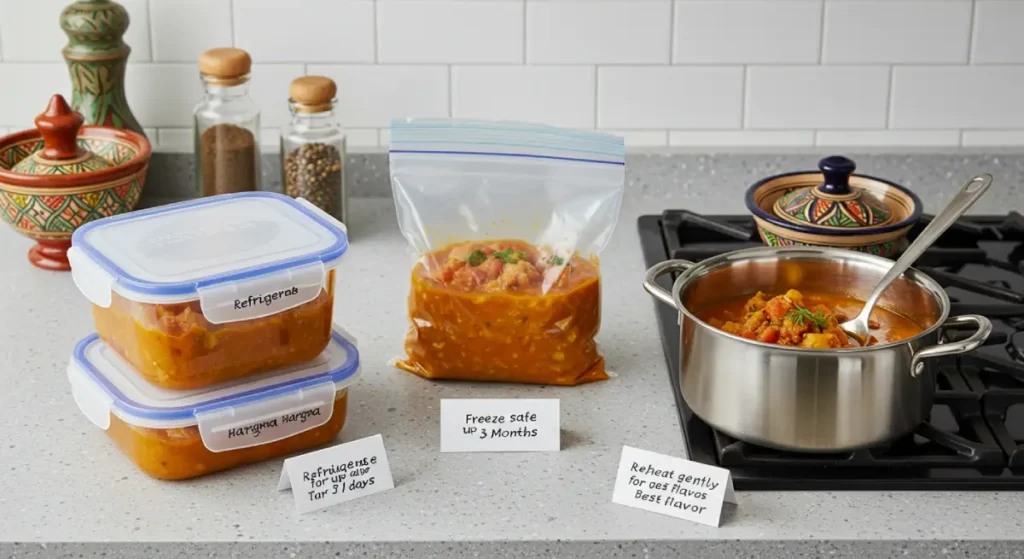
- Refrigeration (Short-Term Storage):
Allow the dish to cool completely before transferring it to an airtight container. Stored in the refrigerator, Hargma will stay fresh for up to 3 days. - Freezing (For Long-Term Storage):
For extended storage, Hargma can be frozen for up to 3 months. Portion it into individual freezer-safe containers, ensuring the broth covers the meat entirely to prevent freezer burn. - Reheating (Retaining the Richness):
- Stovetop: The best method is to gently reheat on low heat, adding a splash of water to restore moisture if needed. Stir occasionally to distribute heat evenly.
- Microwave: If using a microwave, cover the dish and reheat in short intervals (1-2 minutes), stirring in between to prevent overheating.
- Oven: For a more traditional slow-warmed approach, place the Hargma in a heatproof dish, cover with foil, and warm at 300°F (150°C) for 20-30 minutes.
Pro Tip:
Always reheat Hargma slowly and evenly for maximum flavor retention—never rush the process. A fresh olive oil or a sprinkle of saffron before serving can revive the aromatics.
To keep your Hargma fresh and safe to eat, follow these expert food storage guidelines.
Pairing Moroccan Hargma with Other Traditional Tagine Food
Hargma is a staple Tagine food, best complemented by Moroccan bread, Harira soup, and preserved lemons. Traditional Moroccan accompaniments enhance the dining experience, creating a harmonious feast.
- Harira Soup (A Classic Starter)
Before diving into Hargma, many Moroccan households begin their meal with a bowl of Harira, a fragrant tomato-based soup enriched with lentils, chickpeas, and warming spices. This combination ensures a well-rounded meal that is both hearty and comforting. - Khobz (Moroccan Semolina Bread)
No Hargma experience is complete without a serving of freshly baked Khobz, Moroccan bread with a crispy crust and soft interior. It is perfect for soaking up every last drop of the luscious broth. - Olives & Preserved Lemons (Bright & Briny Contrast)
A small plate of green or black olives, alongside preserved lemons, provides a tangy contrast to the richness of Hargma, cutting through its deep, savory notes with a burst of acidity. - Fresh Moroccan Salads
A simple tomato and cucumber salad, drizzled with olive oil and sprinkled with fresh herbs, offers a refreshing, crisp counterpoint to the indulgence of the dish. - Mint Tea (The Perfect Digestif)
To conclude the meal, freshly brewed Moroccan mint tea helps cleanse the palate and aids digestion. The aromatic mint and a touch of sugar provide a light, cooling finish.
Pro Tip:
Serve Hargma family style for an authentic Moroccan feast. Guests can scoop up portions with pieces of warm bread and enjoy the meal in its most genuine form.
Hargma is a dish of tradition, patience, and profound flavor. Whether slow-cooked in a tagine, Dutch oven, or pressure cooker, adequately stored for future enjoyment, or paired with classic Moroccan side dishes, these expert tips ensure that each bite celebrates Moroccan culinary heritage.
🏁 Final Thoughts: Hargma, a Soulful Moroccan Tagine Food
Hargma is far more than just a comforting stew — it’s a celebration of Moroccan heritage, patience, and the transformative power of slow cooking. Every spoonful tells a story of warmth, resilience, and ancestral wisdom passed down through generations. From its collagen-rich broth to its fragrant blend of spices and nourishing ingredients, Hargma nurtures both body and soul.
Whether you enjoy it on a cold winter evening, after a day of fasting, or as a nourishing meal to share with loved ones, this traditional tagine food offers more than flavor — it offers healing, history, and connection.
💡 Craving more Moroccan comfort foods?
Explore our other traditional tagine recipes and discover the rich culinary landscape that makes Morocco so unique — one delicious dish at a time.
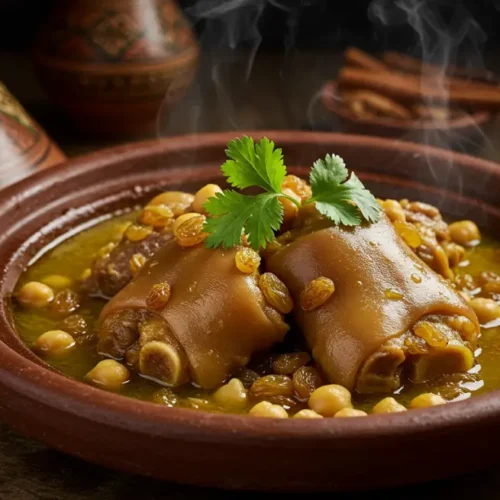
How to Make Moroccan Hargma – A Rich & Flavorful Tagine Food
Ingredients
Main Ingredients:
- 2 beef trotters cleaned and chopped
- 1 cup dried chickpeas soaked overnight
- ½ cup golden raisins
- 1 large onion finely chopped
- 4 cloves garlic minced
- 3 tbsp olive oil
- 5 cups water or bone broth
- Salt to taste
Spices & Seasoning:
- 1 tbsp Ras el Hanout
- 1 tsp ground cinnamon
- 1 tsp ground ginger
- 1 tsp turmeric
- ½ tsp black pepper
- ½ tsp saffron threads soaked in warm water
- 1 tbsp fresh cilantro chopped, for garnish
Instructions
Step 1: Prepare the Ingredients
- Clean the lamb or beef trotters thoroughly and soak the chickpeas overnight.

- In a small bowl, mix Ras el Hanout, turmeric, cinnamon, ginger, and black pepper for the spice blend.
Step 2: Sauté the Aromatics
- In a large Tagine pot (or Dutch oven), heat olive oil over medium heat.

- Add chopped onions and garlic, sautéing until softened.
- Sprinkle in the spice blend and stir until fragrant (about 1 minute).
Step 3: Slow Cook the Hargma
- Add the lamb trotters to the pot, coating them with spices.

- Pour in water or bone broth, cover the pot, and simmer for 3 hours over low heat.
- Stir occasionally and check the water level, adding more if needed.
Step 4: Final Touches & Serving
- Add chickpeas and golden raisins in the last 30 minutes of cooking.
- Adjust seasoning and let the flavors meld.
- Garnish with fresh cilantro and serve hot with Moroccan bread (Khobz).

Notes
- For faster cooking: Use a pressure cooker (cook for 1.5 hours instead of 3-4 hours).
- For a deeper flavor: Let the dish rest for 30 minutes before serving.
- Serving Suggestion: Pair with Harira soup and Moroccan mint tea for a full Moroccan meal.
🧾 Nutrition Information (Per Serving):
| Nutrient | Per Serving |
|---|---|
| Calories | ~450 kcal |
| Protein | 35g |
| Carbohydrates | 40g |
| Fat | 18g |
| Saturated Fat | 5g |
| Fiber | 8g |
| Sugar | 12g (from golden raisins) |
| Cholesterol | 80mg |
| Sodium | 450mg |
| Calcium | 90mg |
| Iron | 5mg |
| Collagen | High (supports joint and skin health) |
💡 Health Benefits:
✔️ Rich in Collagen – Great for skin, joints & gut health
✔️ High-Protein Meal – Supports muscle recovery
✔️ Gut-Friendly – Chickpeas provide fiber for digestion
✔️ Nutrient-Dense – Loaded with vitamins & minerals
📩 Stay Connected with Us!
📩 Join Our Moroccan Foodie Community
Get the best Moroccan tagine recipes and seasonal culinary tips straight to your inbox.
Stay Connected! 📲💬
Love this Tagine food recipe? Share your cooking experience with us! 📸✨ Tag us on social media and use #MoroccanCuisine #TagineFood #HargmaRecipe to showcase your delicious creation. Follow us for more authentic Moroccan recipes, tips, and cooking inspiration! 🇲🇦🍽️ Let’s keep the conversation going! 🚀
🏠 Discover More Moroccan Recipes!
🥘 Craving more delicious Moroccan dishes? Head over to our Home page for a collection of authentic recipes, cooking inspiration, and flavor-packed meals! Explore now! 🚀🍽️


